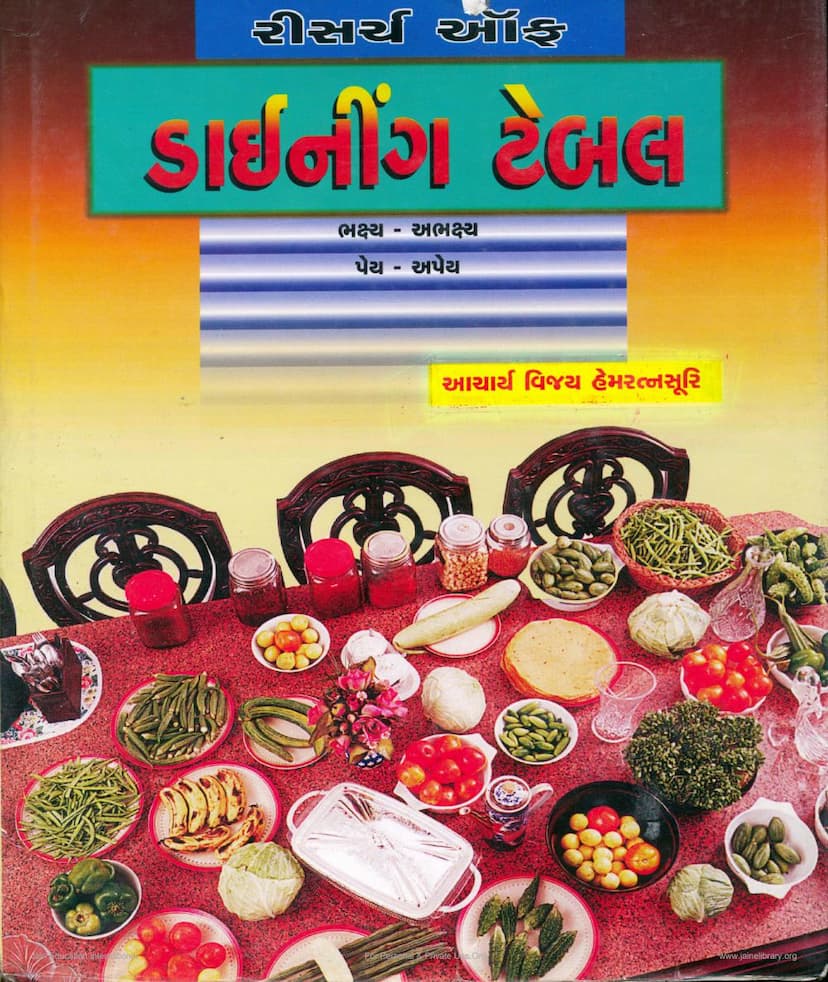Research Of Dining Table
Added to library: September 2, 2025

Summary
The book "Research of Dining Table" (also known as "Ras of Dining Table" or "Rasa of Dining Table") by Acharya Vijay Hemratnasuri is a comprehensive guide to dining practices from a Jain perspective, emphasizing the importance of ahar shuddhi (purity of food) for both physical and mental well-being. The book is published by Arhad Dharm Prabhavak Trust.
Here's a summary of the key themes and content, based on the provided pages:
Core Message:
The central theme of the book is to guide readers, particularly the younger generation, towards a pure and ethical diet as prescribed by Jainism. It argues that this purity in food is not just about religious adherence but is fundamentally linked to physical health, mental peace, and spiritual progress. The author draws parallels between ancient Jain principles and modern scientific findings to validate these dietary guidelines.
Key Concepts and Content:
-
Jain Dietary Principles: The book delves into the Jain concept of ahar shuddhi, which encompasses various restrictions and recommendations related to food consumption. This includes:
- Abhakshya Chart: A detailed explanation and classification of abhakshya (foods that should not be eaten) according to Jainism, often presented with explanations of why they are prohibited (e.g., due to the number of lives within them, the nature of their growth, or their impact on the mind).
- Types of Prohibited Foods: The text lists numerous categories of prohibited foods, such as:
- Anantkay (foods with infinite lives), including root vegetables like potatoes and onions, and certain fruits.
- Bahubeej (fruits with many seeds).
- Chalitras (foods whose taste, color, smell, or texture has changed).
- Dwidala (legumes and their products, especially when consumed raw or with certain other foods).
- Madh, Mans, Makhan, Madira (honey, meat, butter, alcohol) – the four major vigai (foods that excite the senses).
- Night-eaten foods, stale foods, and foods consumed after a certain time limit.
- Certain specific items like brinjal (eggplant), tamarind, and even soil or charcoal.
- Emphasis on Purity: The book stresses the importance of consuming food that is pure in dravya (substance), kshetra (place), kal (time), bhava (intent), and udhyog (preparation method).
-
Health and Well-being: The author consistently links dietary purity with physical and mental health.
- Physical Health: It explains how certain foods can lead to diseases like cancer, digestive issues, obesity, and impact bodily functions. It often contrasts the ancient wisdom of Jainism with modern scientific research, showing how science is now validating Jain principles.
- Mental Health: The book emphasizes the connection between diet and mental state, arguing that impure food can lead to anger, attachment, ignorance, and mental disturbances. It explores concepts like controlling the mind and preventing stress, tension, and anxiety through diet.
- Modern Science vs. Jainism: A recurring theme is how modern science, through its research (e.g., about bacteria, the impact of chemicals, the nature of plant life), is increasingly confirming the wisdom of Jain dietary laws, which were established thousands of years ago through spiritual insight (keval Gyan).
-
Author's Background and Approach:
- Acharya Vijay Hemratnasuri: The book is authored by Acharya Vijay Hemratnasuri, who is described as a prominent and influential spiritual leader known for his eloquence and ability to inspire youth. His background includes accepting monasticism at a young age and extensive public speaking and writing.
- Interdisciplinary Approach: The book blends Jain scriptures and philosophy with scientific findings, medical reports, and even everyday observations to make its points. The language is accessible and aims to connect with the modern reader, especially the youth.
- Inspirational Tone: The author uses storytelling, anecdotes, and direct appeals to the reader's intellect and conscience. He highlights the adverse effects of modern lifestyles and temptations, urging readers to return to a simpler, purer way of life.
-
Practical Guidance: The book provides practical advice, including:
- Reading instructions before meals.
- Understanding different types of water.
- Why certain foods are avoided on festival days.
- Rejecting fast food, processed food, and hotel/restaurant food.
- The dangers of certain common foods like brinjal, potatoes, and honey.
- The importance of timing in meals, particularly the avoidance of night meals.
-
Critique of Modern Lifestyle: The book is critical of the modern consumerist lifestyle, where convenience and taste often override health and ethical considerations. It condemns the prevalence of packaged foods, artificial additives, and the neglect of traditional wisdom.
Overall Purpose:
"Research of Dining Table" aims to educate and motivate readers to adopt a diet that aligns with Jain principles. It serves as a guide to understand the rationale behind these principles, not just as religious commandments but as scientifically and healthily sound practices. The book encourages a conscious approach to food choices for a healthier body, a calmer mind, and a more ethical life.